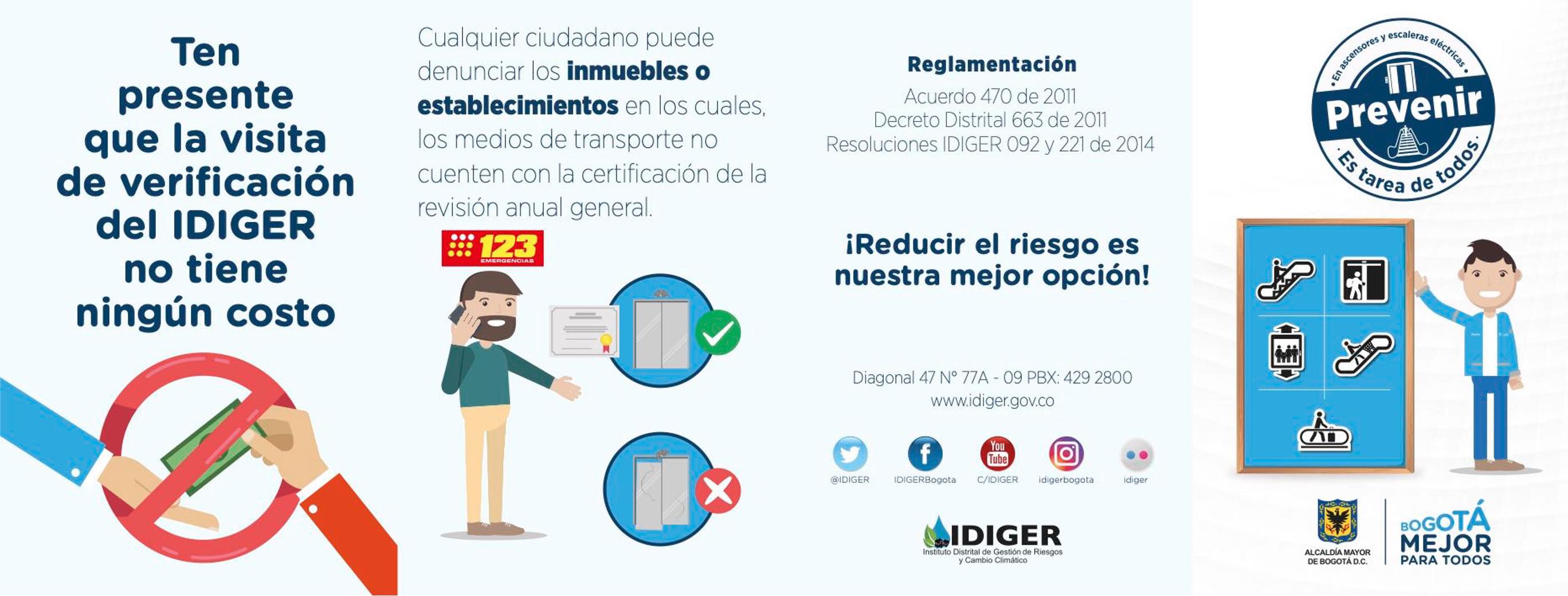With the vertical growth of cities in Colombia and the tendency of people to move to apartments in buildings, elevators become the easiest, fastest and safest ally for you to be transported in a building. According to DANE figures, each year more than sixteen million (16,000,000) square meters are built in Colombia for apartment housing, which is equivalent to approximately six thousand six hundred (6,600) new 6-story buildings.
Due to this growth and with the aim of ensuring that you always reach your destination, in 2011 the Bogotá mayor's office approved agreement 470, with which it is necessary to have an annual certification for elevators. In which it is reviewed:
• Certificate of inspection.
• Annual preventive maintenance schedule.
• Technical report and corrective preventive maintenance supports.
• Instructions for use, warning and precautions.
• Adequate signage.
• Emergency start and stop switch.
• Power station next to stairs and ramps (only for stairs and ramps).
• Protection protocol in case of emergency.
• Procedure in case of maintenance or repairs.
IDIGER visit

This is the step by step that we recommend you follow to obtain your certification:
1. Check if the elevator has already been certified
The first thing you should do is check if the elevator already has any current certification. In the case that it has already been certified, what you should do is a re-certification of the elevator. The recertification process is generally much easier than an initial certification.
2. Verify the list of certifying companies approved by ONAC
Since Bogotá is the city with the most population and the economic center of Colombia, the vast majority of companies operate from Bogotá D.C., so if your elevator is located in Bogotá, you will have the benefit of finding a wide range of certifying companies. In the event that your elevator is located outside of Bogotá D.C., some of these companies have offices in other cities or offer their services to other cities in the country.
On the other hand, the prices of an elevator certification in Bogotá D.C. in 2021 it ranges between $ 300,000 COP - 400,000 COP for each elevator.
3. Requirements prior to certification
On the day of certification, the certifying company will do the initial inspection with the accompaniment of the elevator maintenance company and a representative of the property, it is always necessary that the maintenance company is in charge of doing this monitoring, otherwise, it will not be possible make the inspection visit, in this visit you will verify:
• Inspection certificate: Document and stamp of the revision or passed certification.
• Annual preventive maintenance schedule: The maintenance schedule is the routine that technicians must follow to maintain your elevator. In other words, it is the step-by-step of the items to be verified. At GOLD we have a monthly routine, where specific adjustments and verifications are addressed on a monthly basis, in order to guarantee the safety and good performance of your elevator at all times.
• Technical report and corrective preventive maintenance support: The maintenance report is the report made by the elevator technician or representative, once the preventive maintenance, corrective maintenance, or an emergency call is presented in the elevator.
• Instructions for use, warning, and precautions: The instructions for use and recommendations are the manuals, information, and recommendations that the manufacturer gives to the owner of the building, in case you no longer have contact with the manufacturer of your elevator, you can contact the maintenance company of your elevator, generally have standard formats that meet the necessary information for your elevator.
• Adequate signage: The signage is all the labels that are placed on the elevator control, car, shaft and path, which inform users and technicians about the operation, use and precautions that they should take when using or maintaining the elevator.
• Emergency start and stop switch: Exclusive emergency buttons, used by technicians or emergency personnel to manipulate and block the lift.
• Power station next to stairs and ramps (only for stairs and ramps): Power station and operation control, necessary for use
• Protection protocol in case of emergency: Documentation necessary for rescue in emergency situations. It tells you the procedure you must follow in case of being trapped in an elevator.
• Procedure in case of maintenance or repairs: The GOLD maintenance schedule has four (4) maintenance routines. In each routine, general maintenance of the equipment is carried out and certain elements are specifically verified, this is how in routine one (1) specific activities are carried out in the pit, and lower part of the cabin.
At the end of the first inspection there are two scenarios that can occur: CONFORM, "the equipment complies with all the conditions of the NTC 5926-1 standard", NOT CONFORM, in this case, the equipment lacks one or more requirements of the NTC standard 5926-1.
In either case, the certifying body will send you the inspection report of the first visit. If this report has no pending points, the team can be certified. In the event that the report has one or more points, the respective job quotation should be made with the maintenance company of your elevator.
Have you ever wondered how you can make a successful elevator certification process?
Discover tips to avoid getting stuck in the elevator.
Mantenimiento Normatividad Repuestos